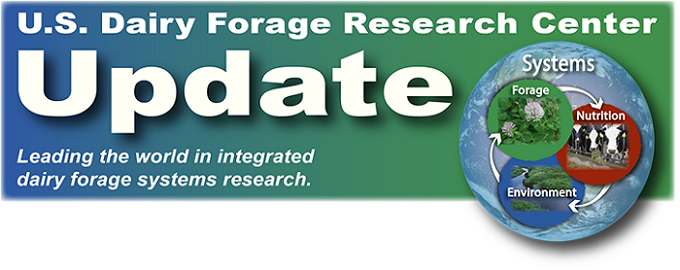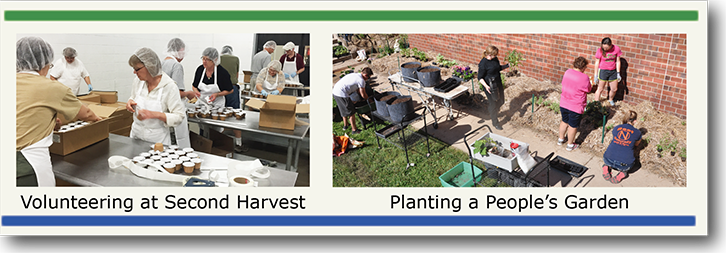
SUMMER 2016
Welcome to the U.S. Dairy Forage Research Center (USDFRC) Update, a quarterly message to keep stakeholders informed about Center research, accomplishments, and activities. This Update features highlights from April through August 2016.
![]()
Summary of Current Research
In June the USDFRC updated its handout about the scientists and added a section on their current research projects. To view a copy of this new document, click here.
Finding forages that use less water to grow and are high in digestibility are needed as alternatives to corn silage. One of the newer projects is an example of the Center’s multidisciplinary research. Dairy Scientist Kenneth Kalscheur is evaluating changes in dry matter intake, milk production, milk composition, feed efficiency, and nutrient digestibility/excretion when brown midrib sudangrass replaces a portion of corn silage in the diets of high-producing dairy cows. And Agronomist Geoff Brink is in the first year of a 2-year study to evaluate various warm season annual grasses and their response to harvest management. Grasses being evaluated are sudangrass, millet, and a sorghum-sudangrass hybrid.
New Grants
In May, Agricultural Engineer Tucker Burch, Marshfield, received a $40,000 grant from the ARS Office of National Programs for the study of “Occurrence and Distribution of Antibiotic Resistance Genes in Groundwater of Kewaunee County, Wisconsin.” Working with him on the project are USDFRC Microbiologist Mark Borchardt, also of Marshfield, and ARS Research Microbiologist Lisa Durso from Lincoln, NE. They will be looking to see if they can find bacterial genetic markers for antibiotic resistance in the county’s groundwater. The work is novel for its large geographic scope.
Plant Geneticist Heathcliffe Riday is conducting research as part of a $1,998,686 grant from the USDA-NIFA-Organic Research and Extension Initiative program entitled, “Creating the Cover Crops that Organic Farmers Need: Delivering Regionally Adapted Varieties across America.” Also participating in this grant are researchers from four universities and two other USDA-ARS locations. Riday received $227,370 to develop new hairy vetch varieties by conducting multi-site breeding efforts with Midwestern organic farmers.
In August, Plant Geneticist Heathcliffe Riday was part of a team that received a $249,494 grant from USDA-NIFA-Alfalfa and Forage Research Program entitled “Managing selfing rates in alfalfa seed production fields.” As part of the team, Riday will assess selfing (self pollination) rates in alfalfa seed production fields using DNA markers, and he will attempt to identify environmental and management factors associated with selfing rates.
Superior Paper
On April 6, Soil Scientist Peter Vadas received notice that his article, “A New Model for Phosphorus Loss in Runoff from Outdoor Cattle Lots,” was selected to receive a 2016 Superior Paper Award from the American Society of Agricultural and Biological Engineers (ASABE). Link to article.
![]()
On May 2 and 3, Dairy Scientist Geoffrey Zanton presented “Protein and amino acid nutrition” to about 400 researchers, educators, students, and industry professionals at the American Dairy Science Association’s Large Herd Dairy Management Conference in Oak Brook, IL.
On May 12, 2016, Agronomist John Grabber gave a presentation, “Update on interseeding alfalfa into corn as a dual-purpose cover and forage crop,” to about 75 forage researchers, Extension educators, and seed production and sales people at the Industry Extension Forage Advisory Council meeting in LaCrosse, WI.
On May 11-12, Center Director Mark Boggess represented ARS at the Dairy Sustainability Forum of the Innovation Center for U.S. Dairy in Oak Brook, IL.
On June 6-8, Plant Geneticist Michael Casler attended the Advanced Bioeconomy Feedstock Conference in Miami, FL, where he met with research collaborators to discuss research results and make plans for the 2016 growing season.
On June 8, Dairy Scientist Mary Beth Hall conducted a training webinar, “An Update on ‘Sugars’ in Dairy Cattle Nutrition,” for 12 dairy nutritionists as a part of their Minnesota and Dakotas Vita Plus training meeting. The update was designed to give these nutritionists the latest research information on how to better work with sugars in diet formulation to get the desired production performance from dairy cows.
The week of June 12, Molecular Geneticist Michael Sullivan attended the Gordon Research Conference on Plant Molecular Biology in Holderness, NH, where he presented a poster, “A reverse genetics approach to elucidating substrate specificity of a hydroxycinnamoyl-CoA hydroxycinnamoyl transferase using transgenic alfalfa.”
On June 20-21, Agronomist Geoffrey Brink represented USDA-ARS at the American Forage & Grassland Council Board of Directors meeting. Brink is chair of the Research Committee which is proposing an industry-led effort to develop a forage maturity index for temperate grasses.
On June 22, Mary Beth Hall gave a presentation, “NDFD and Sugars,” to 165 field dairy nutritionists and specialists at the 2016 Purina Dairy Production Consultant Conference in Wisconsin Dells, WI.
On June 15 and 16, Research Scientist Wayne Coblentz of the Marshfield location traveled to Dubuque, IA to give a presentation, “Heifer stocking density and performance,” to 65 Extension educators, industry reps, and producers at the Four-State Dairy Nutrition and Management Conference.
The USDFRC was well represented at the American Dairy Science Association Joint Annual Meeting in Salt Lake City, UT, July 20-22. Mary Beth Hall gave two oral presentations, “Analysis methods differ in recovery of microbial glycogen” and “Utilization of lactose by mixed ruminal microbes is affected by nitrogen type and level, and differs from utilization of glucose.” Paul Weimer presented “Ruminal dosing with Megasphaera elsdenii and strain persistence are associated with milk fat depression in Holstein cows.” In addition, Mark Borchardt, Geoff Brink, Wayne Coblentz, Ken Kalscheur, J. Mark Powell, Paul Weimer, and Geoff Zanton were primary or co-authors for 14 poster presentations.
On August 24, John Grabber presented “Establishing alfalfa in silage corn” to about 80 producers and industry representatives at the Agronomy/Soils Field Day, UW-Arlington Agricultural Research Station, Arlington, WI. At the same event, Michael Casler presented “Breeding cool season grasses.”
There were eight articles published in various agricultural trade journals April through August, including:
- Manure after alfalfa: Consider the options
- Manure and water concerns spark studyHigh-quality or right-quality forage?
Link to copies of these articles.
![]()
Animal Geneticist Wenli Li joined the USDFRC in August. Her research program will be based on applying a high-throughput sequencing-based strategy to identify genetic/genomic determinants of dairy feed efficiency and production. Li grew up in southwestern China where she earned a BA in Biology. She came to the U.S. to pursue her graduate training and obtained an MS degree in Plant Developmental Biology at the University of Georgia. Driven by the interest in deciphering the interplay between genotype and phenotype diversification, she decided to pursue a PhD in Population Genomics at Indiana University-Bloomington. Before joining the USDFRC, she was a Kern Innovation Fellow and American Heart Association Fellow at the Medical College of Wisconsin with her research focusing on medical genomics.
Other scientist positions that are in various stages of the hiring process and should be filled by the end of the year include: A growth physiologist at Marshfield, a newly created position to conduct research on heifers; a soil scientist at Marshfield to replace the retired Bill Jokela; a microbiologist/ag engineer position at Madison to replace the retired Richard Muck; an animal/microbial geneticist that will complement Paul Weimer’s research program; and another newly created position, an ecologist for the Prairie du Sac farm.
Plant Geneticist Michael Casler received news that he was selected to be the 2016 Calvin Sperling Biodiversity Memorial Lecturer at the upcoming Tri-Societies meeting in Phoenix November 6-9. The purpose of the lectureship is to bring in renowned biodiversity lecturers to share their research experiences, knowledge, and views on biodiversity as they interface with crop agriculture and the interests of Crop Science Society of America. Casler will present “It’s Just Grass, Isn’t It?” on November 7.
In April, Research Soil Scientist Bill Jokela retired from the Environmentally Integrated Dairy Management Research Unit in Marshfield. Bill came to USDA-ARS in September 2005, and he pioneered the paired watershed technique for assessing runoff following the harvest of corn silage. At the time of his retirement, he was conducting a similar experiment with alfalfa/grass mixtures. Bill spent much of his career evaluating different techniques for dairy manure application, with the goals of reducing the associated environmental burdens, maintaining crop productivity, and facilitating technology transfer to dairy producers. Prior to working for USDA-ARS, Bill enjoyed a long and productive career in research and Extension with the University of Vermont.
Also retiring in April was Chris Odt, a technician in Paul Weimer’s lab for 27 years. According to Weimer, “Chris was a major contributor to the microbiology of ruminal fiber digestion; development of continuous culture systems for rumen bacteria; and characterizing the bacterial species composition of the rumen and its effect on the production of milk and milk fat.” For several years, Chris organized the popular Science Day for Kids outreach event which brought 4th grade students from a Madison elementary school to the USDFRC to learn about science. Chris is also an accomplished artist working in pottery and fiber arts.

This Spring, Michael Sullivan and Lila Walters organized a monthly volunteer session at the Second Harvest Foodbank of Southern Wisconsin. Once a month about 10 employees work at the foodbank for three hours of their own time. Second Harvest procures excess or soon-to-expire food from cooperating grocery stores and food manufacturers, and then it repackages the food for distribution to local food pantries. “So far we’ve repackaged eggs, labeled canned peas, and labeled/repackaged applesauce cups,” Sullivan reports. “I've been amazed that, with minimal discussion, we come up with a method to do the task efficiently. Most of the talk ends up being social after that – a great team building experience as well as an opportunity to serve the community and reduce the amount of food being wasted.”
In June, employees planted a USDA People’s Garden on the south side of the USDFRC building. Organized by Technician Diane Amundson, the deep-mulch garden is growing an assortment of vegetables, herbs, and flowers that attract pollinators. The vegetables will be donated to local food pantries.

